Tallinn, the capital of Estonia is the best-preserved medieval town in northern Europe, according to UNESCO, which has designated it a World Heritage Site. They describe Tallinn as "a system of walls, fortifications and authentic buildings, constituting an urban structure formed in the 13th and 14th centuries."
The place you will spend more time at than any other part of Tallinn is the major marketplace of the Town Hall Square. The marketplace is sometimes filled with many dozens of craft boothsTravels in Vermeer: A Memoir selling handmade goods. There's food for sale and restaurants all around. In early July it plays host to the Old Town Days and other medieval festivals happen throughout the year, and is also a venue for open-air concerts, fairs, and more. In winter it becomes an enchanting Christmas market, the centerpiece of which is a towering spruce tree. Our visit was in July when the weather was beautiful and it was not too crowded.
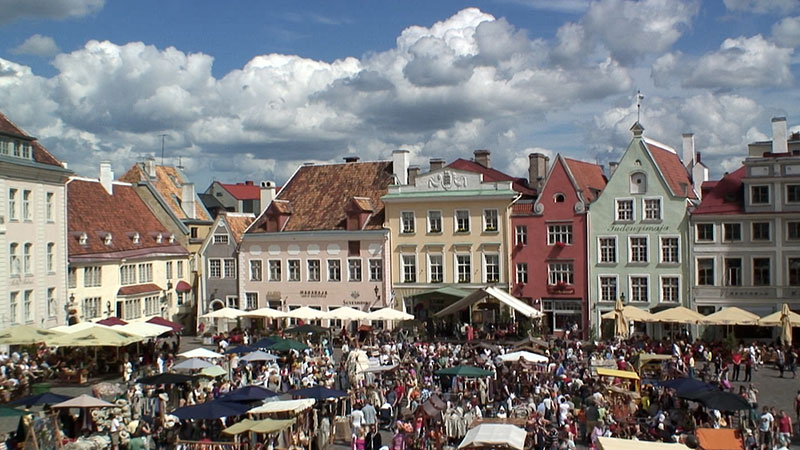
Town Hall Square is the busiest place in town, surrounded by some of the finest architecture, housing, shops, and outdoor restaurants, and beer halls, and the great collection of market kiosks in the center of the square. The City Hall is one of the oldest town halls in Europe and dates back to the beginning of the 15th century. It was a place where the magistrates and mayor would work. Now it's a museum with an outdoor restaurant. We happened to be here at a lucky time in early July at a festival called Old Town Days, with costumed performers and live music from a stage. We'll return for more music, craft booths and festivities later in the story.
We are going to take you on a walking tour of the main lanes and side alleys. The Old Town is relatively small, just one kilometer from one end to the other, but there are so many interesting sights packed in here, your visit will be filled with rewarding experiences.
While tourism has become a major part of the economy, with a million foreign visitors coming in every year, it is still much less crowded and much less visited than other major cities of Europe. Visitor numbers will certainly be increasing exponentially because it is such an attractive destination. So this is a good time to go, before the massive crowds arrive.
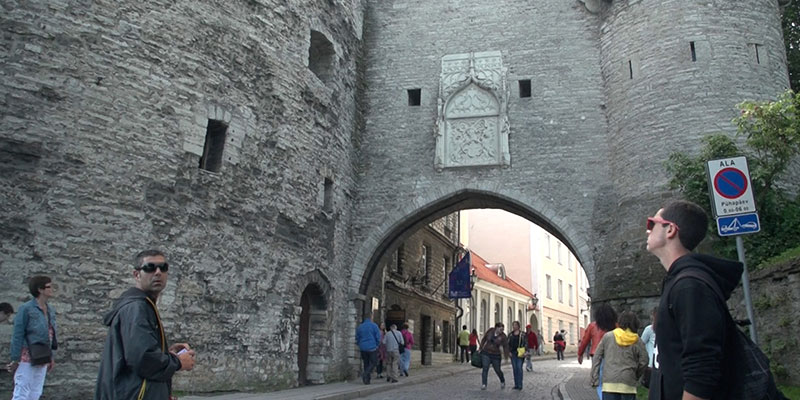
One of the first sights that you'll see approaching from the waterfront into town is Fat Margaret Tower, built in the early 16th-century, rising 25 meters high with walls that are five meters thick. It would have been an imposing and intimidating sight for anybody approaching the town. The Great Coastal Gate is the most crucial entrance of the six remaining gates in the old city wall system. It was the main route for traffic entering the town from the port heading for the market square, first mentioned as far back as 1359.
Entering through the Great Gate is the perfect way to enter town. It's like entering a time machine, right into the main street of Tallinn called Pikk Street. This is the longest street in town, so it's also called the Long Leg because it's the main connection between the upper town and the Lower Town, leading all the way to that Great Coastal Gate, about one kilometer total length.
Tallinn has a few gentle hills, creating an interesting topography where you get some intersections of streets going high and low. One of the first impressive historic site you come upon on Pikk Street is three connected houses called The Three Sisters. These are typical examples of what the dwellings of wealthy merchants would look like in the Middle Ages.
Tallinn has always depended on merchants for its prosperity, and we find many guild houses in this street. They were the headquarters of various merchant organizations.
The elaborate facade and beautiful doorway leads to one of the most interesting of the guild houses. We're in the House of the Brotherhood of Blackheads, and you see here a gothic guild hall. This would have been the principal meeting room inside the Guild Hall, thus the name. And you see the typical Gothic vaulted arches behind me here. There was an organization of young single merchants, so they would have a lot of parties in here, as well as doing a lot of business inside. It was very much a combination of a social gathering place as well as a center of business and trade, a place where apprentices would learn the various kinds of functions. And the guild was really an important organization in the medieval society.
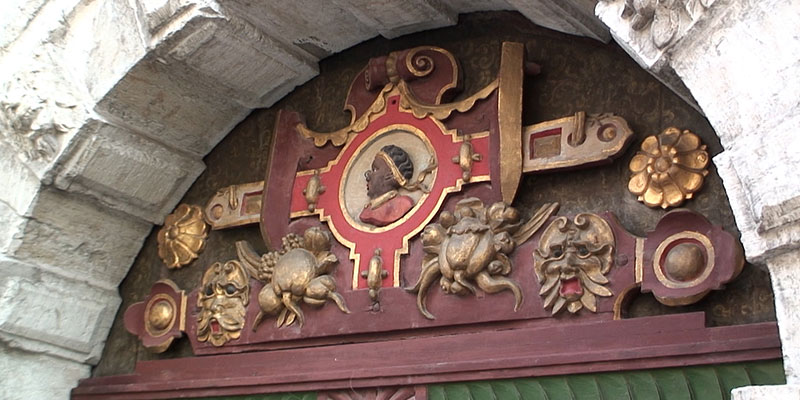
The Brotherhood of the Black Heads is most famous for its little door outside, which is highly decorated in the Renaissance style and has a picture of a fellow who looks very dark. He was a moor, he was the patron Saint Mauritius of the Brotherhood of the Black Heads. Admission is free and it's open every day unless there is a function going on inside. So by all means, step in and enjoy this guild house. We'll come back to this Pikk Street later.
.jpg)
There is another lane parallel to Pikk that is just as attractive called Lai, with a most impressive church.
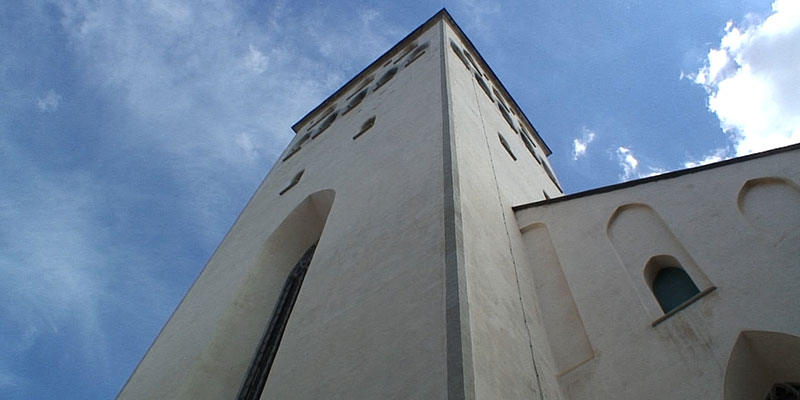
This is claimed to have been the highest church in Europe, and there are some who claim it was the world's tallest building in the late 16th century. They say its height was 200 meters, but lightning has struck numerous times, and the height's been reduced now to 125 meters. It's a Lutheran church but not very active with services.
The Tallinn City Theater has been operating in these old buildings since 1965 with three different theater halls. Some parts of this street can get quite busy with motor vehicle traffic, but there are various side lanes leading off from it that are very quiet and sometimes lead you through buildings in a tunnel. If you'd like to stay here for a couple of nights, you might consider the Meriton Old Town Hotel located on Lai, just 200 meters from Old Town square.
Wander through the nearby little lanes, and you will soon come upon a section of the wall that you can actually walk on for free. The oldest sections of Tallinn's city wall were built in the 13th-century.

During the next 300 years, it became one of the largest and strongest defense systems in all of northern Europe. More than half of the magnificent defense system has been preserved, which includes nearly two kilometers of the wall, 26 defensive towers and two major gates. It would be very easy to miss this wall-climbing adventure, so be sure to look for it.
It's right here in the center of town. And if you like, you can climb higher, right up to the top of one of the towers from which you get a beautiful view looking out over the town.
To get the best views of the old town, you need to do a little walking uphill to the Upper Town, 400 meters from that wall walk.
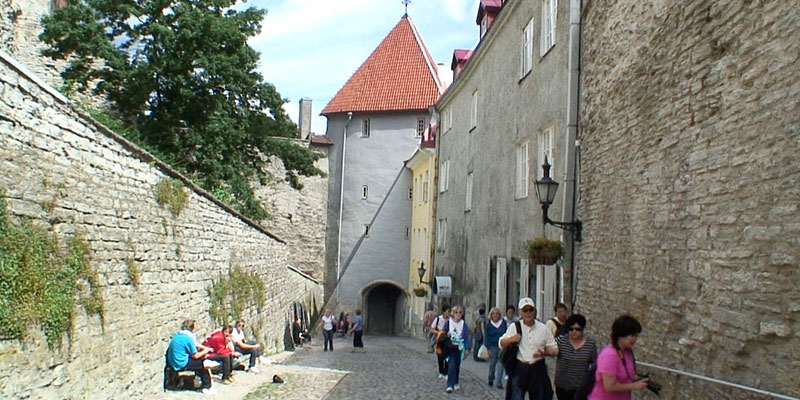
One way to reach the Upper Town is walking through that fortified gateway that was part of the barrier between the upper and lower towns, on an extension of Long Leg street, the main street of town. Artists are displaying their paintings, and here some young gals selling postcards and the Tallinn Card, the discount card. While the Lower Town is the most captivating and charming part of Tallinn, you want to be sure to go to the Upper Town, which was for the nobles, the upper class who ran the society. It has some very large, impressive palaces and a wonderful viewpoint looking down on the Lower Town.
The Upper Town is relatively small, just about 15 acres, while the Lower Town is four times larger. The streets were laid out as far back as the 13th century, and they still have the same basic pattern today.
.jpg)
Alexander Nevsky Cathedral was the last building erected in the upper town in 1900, built in the elaborate Russian style of architecture, reminiscent of the 16th- and 17th-centuries with large wooden front doors that were made in the Ukraine. The cathedral has five domes shaped in a traditional onion cupola style, with the main dome symbolizing Jesus and the other domes representing his disciples.

The pink palace is the Parliament building with 101 members who are elected every four years. St Mary's Cathedral, also called the Dome Church, is located in the heart of the Upper Town, and it's the oldest church in Tallinn, built in the early 13th century. But then in 1684, a great fire took place and the building was reconstructed in limestone, which is the most available material in Estonia, the national stone. It's still functional as an active church and has a congregation of about 300 people.
There are a couple of lookout points up here where you get splendid views looking down at the Lower Town, especially at the city wall, and the watchtowers, and the clay tile roofs of the old buildings. There are 26 of these medieval towers still standing and nearly the entire wall is intact.
It's a remarkable example of medieval preservation. As we continue along through the Upper Town, looking at a few more of these noble structures that had been palaces, another nice feature of the upper town is a small park with greenery and trees. When coming down from the upper town, you get spectacular views of the wall that protected Tallinn in the Middle Ages.
The Danish King's Garden marks the boundary of the upper town, or the Castle, and the lower town. You can clearly see how this was a divided community, separated by class and location, with the aristocrats living up above and the merchants living down below.
While walking through the Danish King's Garden you can see a wooden defense passage on top of the wall that joined the towers together, which enabled the defending soldiers to walk from one tower to another. This marks the boundary of the Upper Tand Lower towns. What could make this idyllic scene any more perfect? How about a wedding? The locals are out, all dressed up celebrating their friend's marriage.

When finished with the Upper Town, it's quite easy to get back to the Lower Town. It's all downhill, perhaps returning the same way you came up along the Long Leg street where you're going to find more of those paintings and crafts on display. Perhaps return back to the arch through the fortified tower, but there is a different way to get down for some variety.
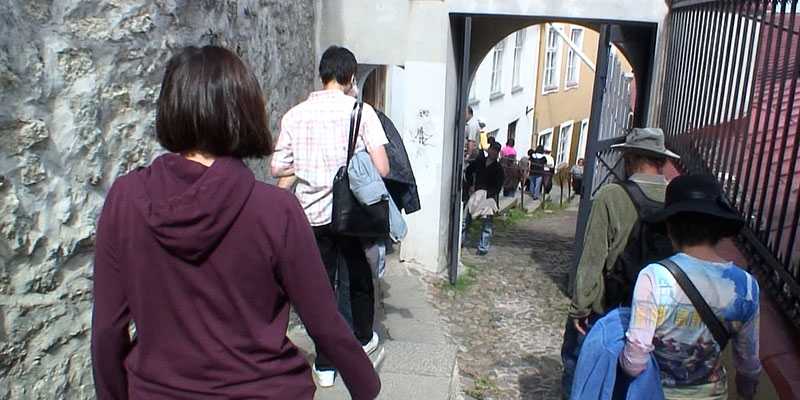
Take a right and enter a staircase that will lead you on a shorter route back to the Lower Town. And they make it quite easy to walk downhill with the stairs. It's always nice to have an alternative route in your round-trip so you can walk uphill on a gradual incline, which is quite easy, and then downhill on a staircase, also very easy. This will lead you back into the center of the Lower Town, where you can continue your explorations, there's a lot more to see. Maybe by now it's time for a meal or to continue along White Bread Passage, which has the smallest house in Tallinn, a former bakery, now a souvenir shop.
Katerina Käik, or St Catherine's Lane, is one of the nicest streets in town because it's a quiet respite with this ancient architecture, a perfect medieval gem. And it's lined with open studios that function as everyday work rooms for the artists. So you can step inside and see the craftsmen at work and purchase their products directly from the artist. It's a little bit hidden away, like a peaceful oasis, remote from the hustle and bustle of the rest of town, a classic example of the medieval alley, with stone support beams and arches holding up buildings and protecting them, keeping them standing for all these centuries.

Here you can see with your own eyes the craftsmen doing their daily work, making ceramics and hats, blowing glass, selling hand-woven fabrics, and have a chance to chat with the artists. This group of artists is the Katerina Guild, a symbolic bridge between the past and the present. Integrating eight studios and 14 women artists. As is customary in the guild system here, also you find master craftsman as well as apprentices. Athough each studio has its own character, they are united in the principle of openness. People return here to enjoy the deliberate pace, remote from the hustle and bustle of everyday life. It is just a little connecting lane between two larger streets the you could easily miss. So look for it as you're walking along and you will find this little art oasis.
2up.jpg)
Katerina Passage is named after the adjacent St Catherine's Dominican Monastery, one of the oldest buildings in Tallinn, dating back to the mid-13th century. It has a garden cloister surrounded by the monastery and a giant old wall. The Gothic interior has different rooms where monks lived and studied. The monastery also brewed four different types of beer. It's a little hard to find this, but it's just off of Katerina Passage. Admission is included with a Tallinn card, otherwise, you pay a small fee in the lobby.
2up.jpg)
When you come out of that tunnel, you hit the wall, another spectacular part of the medieval fortifications of Tallinn. It's often a challenge in our travels nowadays to be able to purchase something that's locally made, let alone handmade. Well, here you have a beautiful collection of handmade sweaters, all authentic, tucked away under the shelter of this impressive section of the medieval wall.
And then after you've seen the main site, it's always nice to just simply take a walk off the beaten track, perhaps down some of the little side streets. They might not be in the tourist guidebooks as important visitor attractions, but it's all part of the ambiance of this remarkable medieval town. Wandering through these little back lanes, getting away from whatever tourists are in the main square is always a thrill, to enjoy the quietude and beauty of these authentic buildings.
In addition to that cluster of craft workshops along Katerina Käik, you'll find plenty of galleries scattered through town with contemporary works by local artists. While most of the buildings date back to the 14th through 18th centuries, there are quite a few with the Art Nouveau style of architecture, which was popularized in the late 19th and early 20th-century in England and Belgium and France.
There is an impressive history museum inside what had been the headquarters of the Great Guild. This was the most important of the merchant societies. In 1987, this impressive Gothic building was converted into the Estonian History Museum with a fascinating collection covering a wide variety of topics, bringing these old tales back to life with very contemporary displays, all housed in this Gothic structure, which has been beautifully preserved.
.jpg)
In a poignant display sign, the curators sum up the national character, asking, "Which word has enough power to encapsulate the survival of the people who have lived on this piece of land for 11,000 years? That word could be perseverance. Perseverance helped Estonians survive amid a harsh climate and rocky soil. After all the wars and conquests, plagues and famines, the steadfastness and even stubbornness of the people here created a distinctive environment and unique culture. The Estonian spirit is meant for survival."
Estonian history extends across a long and winding road through time, telling the tales of many conquering nations, including Viking, German, Swedish, Danish, Polish and Russian invaders. The Republic of Estonia has been independent since 1918, interrupted by a half-century-long Soviet occupation following World War Two. Estonia restored its independence in 1991, and today is a thriving and forward looking member of state of the EU and NATO.
Preserving their treasured historic traditions and festivals, yet, as a very modern country, they've always been traders. Appropriate that the town square today is filled with the merchants on many summer days. This has been going on for more than 700 years. After all, it was founded as a trading town. It was part of the Hanseatic League, which was that northern and European medieval alliance, Germans, Scandinavians, merchant centers trading with the East and bringing goods on into Europe and being the middlemen and always taking a cut of the profits.
.jpg)
The Estonian culture is a really modern society set in these medieval trappings, so don't let the buildings and costumes fool you. These are very modern European peoples, very technologically advanced. They've got some of the highest rate of Internet connections and broadband speeds. For example, a couple of Estonians are the inventors who created Skype for the computer, for making long-distance phone calls for free. And many other technological innovations have come out of Estonia, which has been called the Silicon Valley of Europe, recognized as the world's most advanced digital society. Nearly all interactions with the government are done online, perhaps one reason they have the most business startups per capita, where it only takes 5 minutes to found your own company.
They have one of the world's highest adult literacy rates at 99.8%, and they were the world's first country to adopt online voting in 2005. Ever since the Middle Ages, Town Hall Square has been the center of life. It's been a place where people come to buy things and sell things and listen to the latest gossip. So it has always been a bustling area.

The city hall itself is the main building on the town hall square. It's the best-preserved town hall in the Baltic and Scandinavian states, dating back to 1402. The Town Hall has a couple of waterspouts in the shape of dragon heads, which they believed offered protection against the evil spirits. The ancient Estonians were quite superstitious and very fond of all kinds of symbols.
The Town Hall has a small museum inside with costume attendants to explain the history. The magnificent building recently celebrated its 700th anniversary. Soaring Gothic arches, woodcarving, tapestry and paintings reflect the wealth and ideals of the former Hanseatic town. You're welcome to walk up the narrow spiral steps to the upper level, where you will see the impressive wood beams that are still holding up the roof, 700 years later. A scale model shows the extent of the medieval walls going around the upper and lower towns.
The building also functioned as a courthouse from the 13th through the 19th centuries. It's well worth going to the upper floor because, looking out the window, you have a grand view of the upper town and right down into the marketplace itself. That little tourist train provides an easy way to get around and see the sights. We're going down there in a moment to join the fun and listen to more music from those costumed performers, but first, there are a few more things to show you -- a busy street, another little church and a modern shopping mall.
There are two famous restaurants with traditional food just a block beyond the Old Town Square, out the southeast corner, the Olde Hansa, with an authentic style of decor on the inside and Peppersack, both offering an extensive menu with traditional cuisine. In and around the square you will find many other places to enjoy a fine meal.
Church of the Holy Spirit has the oldest clock in Tallinn, made in 1684 and still works. Built in the 14th-century with a wooden interior, the church is one of the oldest and finest structures in Tallinn.
.jpg)
The oldest part of the church is the choir, and the aisle was added sometime later. This was the first church in Estonia to hold services in the Estonian language. The main altar has a remarkable wood carving that dates from 1483.
This is one of the widest and busiest streets in town, and it leads to the other major gate through the medieval wall that heads down towards the waterfront and a shopping mall. The crowds here are a reminder of how popular Tallinn is with the visitors.
This street ends at the Viru Gate, with the cruise ship docks just beyond and parts of the modern town adjacent, which makes this entrance a lot more crowded than the north entrance that we initially entered at the beginning of the program. There's also a lovely green park just beyond the wall next door. We find a real contrast with the Old Town, this modern Viru shopping mall.
A hotel and office buildings are also attached to it, leading right into the modern part of downtown. From here, it's just a short walk back to the cruise ship terminal, where we'll board our overnight cruise to Stockholm.
The excellent preservation of this medieval architecture is a result of about three major factors. During the 13th and 14th centuries, it became a very important trading center, part of the Hanseatic League. And therefore, these buildings were constructed and built up in a grand style befitting the wealth of this community.
After a few hundred years of trade and expansion, the prosperity tapered off. The trade moved to other places, and Tallinn was sort of left behind in the wake of history. And then in the 20th century, it was occupied by Russia. The Soviets controlled Estonia for much of the 20th century, but that communist government never did much damage here. It's
Fortunately, they did not have any money to knock down old buildings and put up new buildings. And so because of that, Tallinn was just sort of left alone, perhaps even neglected. But happily for the visitor and for the people of Estonia, it survived as a great symbol of their national pride.
The buildings date back to the 13th-century, 14th and 15th centuries, and some a little bit later in the Renaissance and the Baroque, yet with practically no modern buildings. And most of the shops are independent type boutiques -- very few of the big chain stores here in the Old Town. As you walk along and look down side lanes, you occasionally see parts of the medieval wall, another reminder of the antiquity of this town that we're walking through.
A few more thoughts from UNESCO's justification for naming Tallinn a World Heritage site:
It is “a unique example of the coexistence of a seat of feudal landlords and a Hanseatic center in the shelter of a common system of walls and fortifications; an ensemble of mostly authentic buildings constituting an urban structure formed in the 13th and 14th centuries; a radial steel network, town wall, monastic ensembles and a characteristic skyline visible from a great distance on the sea…The Castle and the Hanseatic town of Tallinn were, in the 13th through 16th centuries, among the remotest and most powerful outposts of civilization in the northeastern part Europe. It is a well-preserved ensemble in the chain of trading towns on the Baltic seacoast."
Tallinn is relatively easy to see in a day because it is not all that large. You could walk from one end to the other in 30 minutes. There are approximately 500 building complexes in the town, all of them old, and the streets are for pedestrians. By and large, there are signs to help you out and the pedestrian zone is quite easy to navigate.

Tallinn does not get too crowded with tourists because it is a little further away from the center of normal European travels. After all, we're at the northern fringe of Europe. Estonia is not right next to any other major tourist countries. It's up there in the Baltics by Lithuania and Latvia and across the Baltic Sea, you find Helsinki, Finland, which is where we come from in our visits. More about that later. So Talon's physical isolation makes it somewhat of an untouched gem -- very much worth visiting.
ARRIVE BY SHIP
Since Tallinn is a bit remote, way up here in northern Europe, it's a slight challenge to get here. Of course, you can fly, for example, from Berlin, it's about a two-hour flight, so that's easy. But ground transportation is somewhat more difficult. One of the most popular options is coming to Tallinn on a short cruise from Helsinki, a two-hour boat ride across the Gulf of Finland.
.jpg)
The ship is quite comfortable with open decks, you can walk around, there's restaurants on board. You could have a simple snack or one of those elaborate buffet meals. Maybe use some of your French fries to feed the seagulls hovering around. On board the ship, it's a lot of fun. There are restaurants, lounges, there's shopping, and comfortable seating. You could get a private stateroom if you like, but the ride is short and the public lounges and decks are quite comfortable as you walk around and explore the ship.
When you get to Tallinn, it's an easy ten or 15-minute walk to the Old Town. If you're traveling with luggage, you can check it in a secure room at the Tallinn arrival building. And then, as we did, spend the day walking around in Tallinn, then take a boat back to Helsinki. Or better yet, take an overnight boat to Stockholm -- makes a wonderful package.
It's an easy stroll from the marine terminal over to the old town, crossing the street and through a little park area. Just watch out for the trams going by on this busy road, so be sure to use a crosswalk.
.jpg)
As promised, we're returning to end our visit at the marketplace Old Town Days, which takes place on the first weekend of July, featuring craft booths, clothing, games and festivities of the Middle Ages.